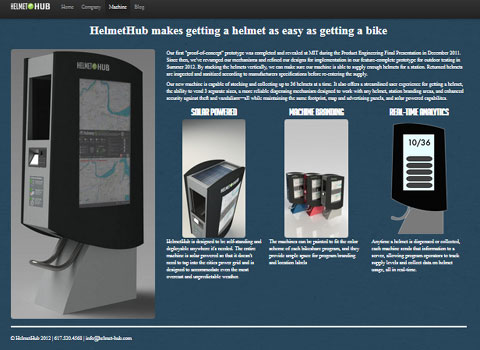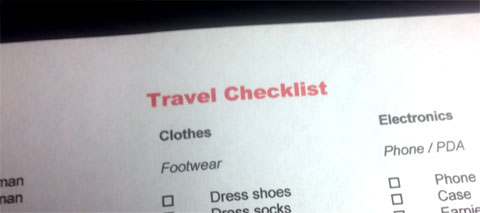Follow-up On Divvy Bikes And Helmets – Boston Debuts Helmet Vending Machine
About a month ago I wrote here on The Hot Iron about how Divvy, the extremely popular bike sharing program in Chicago, did not offer helmets. I also discussed several options for them to offer helmets to their riding customers, including people selling them to the idea of a helmet vending machine.
Little did I know such a helmet vending machine had been developed, and last week was introduced in Boston for its bike sharing program. HelmetHub is a vending machine which was born out of MIT, and offers to either sell or rent a helmet. The vending machines have a style similar to the bike rental stations in Boston and Chicago (which are run by the same company) and will fit in well with those stations.
You can read more about HelmetHub on their Web site and see pictures and options for the vending machines.
It’s great to see such a service offered, and nice to know I was not the only one thinking along this line.
Would you buy a helmet from a vending machine? I welcome your thoughts in the comments of this post.
This is from The Hot Iron, a journal on business and technology by Mike Maddaloni.
Did you enjoy this? Subscribe to The Hot Iron by RSS/XML feed or Read by Email.
Build • Business • Strategize • Technology • (2) Comments • Permalink
How I Took An Idea And Made It A Reality
 With all the ideas and events swirling through the Windy City during the recent Chicago Ideas Week, one of those thoughts was what I would like to share here, how I took an idea I had and made it a reality. Though this story took place a few years back, it is still very vivid in my mind.
With all the ideas and events swirling through the Windy City during the recent Chicago Ideas Week, one of those thoughts was what I would like to share here, how I took an idea I had and made it a reality. Though this story took place a few years back, it is still very vivid in my mind.
My idea was to create a piece of marketing collateral for my Web consulting business. In this case, I could leave it would a prospect client, allow it to be downloaded from the Web and simply put it out there in printed format, the last 2 cases would be for anyone who wanted it. Depending on where the prospect was, it could server anywhere from a calling card, functional tool or a call to action to contact me.
Origin of the Idea
In my Web consulting business there were 2 categories for prospects – those who did not have a Web site and those who had one and were looking to possibly redesign and/or rebuild it. Where there were many common elements between the 2 for the sales process, when talking with someone who already had a Web site there was always a level of ambiguity to what exactly they needed or wanted to do and to what extent.
To try to streamline this process in a non-intimidating way, I thought of a form of checklist, where someone could read off the list to see if they had any or all of the items incorporated into their Web site, or at least to pose the questions in the event they didn’t know. In my mind’s eye I had a partial vision of the checklist. I saw it as paper-based, as likely someone would read a question from it then look on their Web site on their computer’s monitor for the answer. I wasn’t sure if there should be a score of some form or not. I was very sure I did not want it to be too technical and I did want it targeted to the business owner.
As for what would be in the checklist I had some ideas, but this was something I wanted to put time into over a period of time, then organize them into the checklist.
Like Rodney Dangerfield’s Joke Bag
The process of collecting the items for the checklist had me recalling a story I once heard about the late-great comedian Rodney Dangerfield. Before he got into comedy, he was a salesman and would write jokes on pieces of paper and put them into a duffle bag. When the bag was full, he had the material he would use on stage.
My approach was similar, yet different, as my duffle bag was digital – consisting of folders on my hard drive and in my email program. The ideas I captured varied from text files to links to other Web sites to email newsletters, where some of these items were direct ideas and others either categories or thoughts. I let this collection come together over a period time (exactly how long I do not remember). Then one day I decided to start the process to build the checklist.
Molding the Ideas into the Finished Product
As the collection process had elapsed some time and I didn’t remember everything I had put together, I decided I would go through them, one-by-one and begin curating a list. This was facilitated with the help of my whiteboard. As I read an item, I checked if it I already had it on the board, and if not I added it in some semblance of order. When all was done, this is what my whiteboard looked like:

At first glance, it is a mess. But it was the first pass at the organization of the items and ideas. Needless to say it was worthy of a picture!
From here, I started typing up the ideas, and in some cases I would combine like or similar ones. As I typed them up, I erased them from the whiteboard. At the end of this process hundreds of files and emails were in a clean list, just as clean as the whiteboard now was.
The next step was to boil the list down to a manageable, 1-page list, with the top, most important items on it. This was done over several days, as I would look at the list for a while, then revisit it later with a fresh brain. In the end, I finalized a list of 34 items and broke them down into 3 categories – business, content and design. I also came up with some copy to describe the checklist to put on the reverse side of it. At this point I felt really good about the checklist. Well, except for the name of it.
(Queen’s) Landing on the Right Name
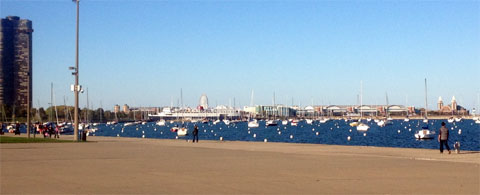
The original name I had for the check was, and get ready for it:
The Web Site Redesign Self-Assessment Checklist
Yes, it sucked. Here I spent all of this time and produced what I felt was a quality product, yet the name would surely be a turn-off, and in some cases scare off people. I decided to put the completed checklist aside as I needed some more quality time to get the name right.
On a Friday evening after work, I went for a walk along Lake Michigan. Armed with a good cigar, I just needed to clear my head after a busy week and stretch my legs. As I was strolling by Belmont Harbor, the topic of the checklist name came front in center in my head. I recall shaking said head and saying to myself, “why don’t I have a better title for this” and the gears in my head started to crank.
As I headed south along the lakefront path, I started decomposing the goal of the checklist. The thought process went something like, “it’s where your Web site is now… it’s a point in time… it’s the current state your Web site is in… wait, that’s it – it’s the State of your Web Site!”
I stopped where I was, at a place along the lake called Queen’s Landing and called my office line and left myself a voicemail message on the name so I wouldn’t forget my inspiration. When I got back from my walk I edited the Word document with the name and then registered the domain name for it.
The State of the State Then and Now
Upon completing the checklist I setup a download page for it and promoted it here on The Hot Iron and elsewhere. I printed copies of it to give people in person and to bring to events as a leave-behind. Although the list never was mentioned on the cover of the Wall Street Journal, it would get a handful of downloads each week and I got good feedback on it from prospect clients and current clients as well.
Now almost 3 years after I created the checklist, it needs to be updated a bit, which would come probably after a new brainstorming session on it. That being said, there are many core concepts on the checklist that are still very relevant today as-is.
See for yourself – download a copy of The State of Your Web Site here right now!
Ideas, Visited
Ideas are just that, intangible thoughts. Without any action, they will remain in that state, floating out there. I know, as The Hot Iron is full of ideas I have had over the years. Where I have acted on many of ideas over the years, I am very proud of the creative process I have just shared here.
Your thoughts – and ideas – on the checklist and the process which led to it are welcome in the comments.
Editor's Note: This post was updated to correct and replace broken links.
This is from The Hot Iron, a journal on business and technology by Mike Maddaloni.
Did you enjoy this? Subscribe to The Hot Iron by RSS/XML feed or Read by Email
Build • Business • Strategize • Technology • The State of Your Web Site • Thrive • Web Design • Web Development • (0) Comments • PermalinkSharing My Travel Checklist
There once was a time I traveled so frequently for work that I had no time to think about what to pack. These days I travel so infrequently that I always forget what to pack. Both situations had one common denominator – my travel checklist.
What started out as an on-going list so I wouldn’t realize I forgot something when I got to my destination became an essential tool for every travel excursion, from overnight to weeks at a time. Whether I’d print it or simply reference it after I packed, the checklist has been invaluable to me for years.
Perhaps it will be to you as well, which is why I have decided to share it. You can get your own copy of my time-tested, evolved travel checklist in PDF format here. Go ahead – take it, edit it, adapt it for what you need for yourself or others and use it. You can see it is geared towards an individual male, but you can add whatever categories or accessories you need for yourself, partner, kids, pets, electronics, etc.
If this travel checklist comes in handy for you, please let me know in the comments. If not, any critique is also welcome as well.
This is from The Hot Iron, a journal on business and technology by Mike Maddaloni.
Did you enjoy this? Subscribe to The Hot Iron by RSS/XML feed or Read by Email.
Announcements • Strategize • (1) Comments • Permalink
Divvy Bike Sharing In Chicago Needs To Offer Helmets
Chicago is all about bicycles. From casual riders along Lake Michigan to people taking their bikes to work every day to everyone in between, there are bikes all over the streets and trails in the Windy City. This intensity has been raised in the past few months since the Divvy bike sharing program has started.
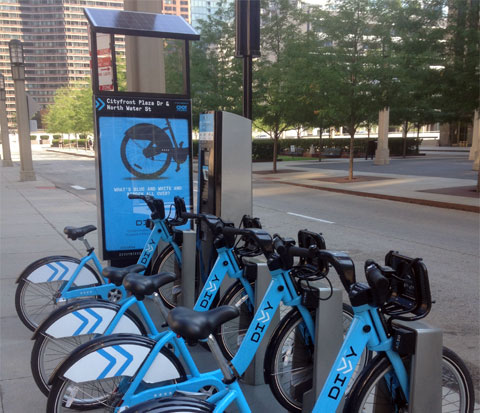
Take a look at this picture and see if you can see – or not see – what I don’t see. This gave me my idea. With additional inspiration from a recent safety video contest that Divvy ran, as well as the upcoming Chicago Ideas Week, I’d like to share and detail my idea for the Divvy program.
First What is Divvy?
Divvy is a service owned by the City of Chicago and run by a commercial third-party company that offers similar services in other cities. The idea of bike sharing is for taking short bike trips around the city, where you rent a bike from one bike station location, as pictured above, and return it to another. The keyword is “short” as you have 30 minutes to go from one bike station to another. You can pay US$7 per day to use a bike for unlimited 30 minute trips, or you can also buy an annual pass to use the service daily.
The bikes themselves are also custom designed, 1-speed bikes with lights powered by pedaling and more rugged than a standard personal bike. The front wheel locks to the station until it is rented. The seat is adjustable and there is a front rack for carrying items. All bikes have fenders covering both tires to keep you drier in the rain, and are light blue, matching the color in the Chicago flag (with the exception of the one red bike).
Divvy Bikes Are (Almost) Everywhere
Since their rollout, barely a block goes by without the sight of a Divvy bike in motion. Though the intended market for the service is city residents, tourists have been renting them as well. The tourist element may not have been anticipated as there have always been options to rent bikes, carriers and even get helmets from the rental shop. For as bike friendly as Chicago is, bikes are often playing a dangerous game with cars for the same street real estate throughout the city. Where marked bike lanes and even some with dividers exist, they are not everywhere, and many say not as much as are needed.
As you may have guessed by now, there is one thing missing from the Divvy bike program – bike helmets.
Divvy just rents bikes, it is up to the rider to get their own helmet, as is stated in the user agreement on their Web site. However, there are not many retail locations in the city where you can buy helmets. With the launch of a social media video safety campaign the lack of a helmet offering represents a huge missed opportunity.
What Would Have Been My Entry In The Divvy Safety Contest
This would have been my submission for the Divvy safety video contest, a 6-second video I created with Vine. Had I gotten to this earlier, I would have submitted it, but alas I missed the deadline. It’s embedded below, or follow this link to view my Divvy bike helmet video on Vine’s Web site.
Some Realities Of Helmets
Before I get into details on the offering of helmets, a little setup first. There is no law in Chicago or Illinois mandating the wearing of bike helmets, and I am not advocating one. Personally when I ride a bike, I always wear a helmet, especially as I once flipped my bike and I was glad I was wearing one! As one who believes in helmets, coupled with the Divvy user agreement stating you should wear one, there is an economic opportunity being missed by not offering them, not to mention the potential safety issues with tourists who may not know where they are going meandering the streets of Chicago.
If you look at the above photo and video again, you will see the Divvy bike stations are designed to dispense bikes, and not helmets, which poses its first challenge. Another challenge comes with the various sizes of helmets needed, as a helmet should fit snug on your head to be effective. Finally, if you are going to reuse a helmet it should be disinfected (think bowling shoes!) or each person would get a new, unused helmet.
Challenges as they may be, I see a couple of approaches to handling – or plain out selling – helmets, both in the short term and long term for the Divvy program.
People-Powered Sales
You don’t have to go far in Chicago without someone trying to sell you something. From the legitimate sales of newspapers and the Streetwise magazine (which I had a previous idea on, but I digress) to people hawking water, self-made CDs or pure panhandling. Why not have people sell helmets direct to riders as select Divvy stations?
The setup for selling helmets can be simple – wheeled duffle bags full of varying sized helmets, mobile devices with Square-like credit card swiping done by a person wearing a Divvy shirt. If sales of helmets are brisk, inventory can be replenished by the already on-the-road Divvy vans which are restocking bikes at certain stations.
Innovation For The Long Term
You may have seen vending machines selling electronics or other items at airports, train stations and even rest stops on highways. There is even an “ATM” in Chicago that vends cupcakes!

Why not a vending machine selling helmets, integrated into each Divvy bike station?
As Divvy bikes and the stations were engineered for their use, so would the bike helmets and the vending machine. I envision a unique helmet designed so a large quantity of them can be stored in a vending machine. The helmets may also be designed to be adjustable so that fewer sizes are needed? I don’t know the answer to how this would work, but I bet there is an engineer who could figure it out. The vending machine itself would be designed to not take up much space and integrate with the current purchasing function of the station.
Beyond The Helmet
As the typical cost of buying a helmet is more than the cost of a daily rental of a Divvy bike, marketing and sponsorship opportunities could decrease the cost of helmets. Would Nike or Groupon or PNC Bank pay money to put their logo on what is in essence a traveling billboard around the streets of Chicago?
And while they’re at it, where are the ads on the bikes themselves? It would certainly contribute to what is in essence a taxpayer-funded program.
Take My Idea Please!
Though Divvy is still a few months old, it has great popularity and exposure. My idea isn’t the only one out there for the service – this story is on an app created by a Chicago resident for logging miles, but was taken down as it violated the Divvy terms of service. Of course if Divvy made available – or even sold – data or the capacity to access it via an API, then there could be even more innovation and potential revenue.
As I myself am in no position or have the time to act on this idea, go ahead and take it and run with it. All I ask in return is a pat on the back and maybe the first helmet off the assembly line.
I also welcome your feedback – and ideas – in the comments of this post.
This is from The Hot Iron, a journal on business and technology by Mike Maddaloni.
Did you enjoy this? Subscribe to The Hot Iron by RSS/XML feed or Read by Email.
Business • Strategize • Technology • (1) Comments • Permalink
Why I Sign My Email Messages As I Do
It’s a question that comes up several times a year, and people have been asking me it for decades now. As many times as I have answered it, I have yet to write it down. Why I haven’t I don’t know for sure, but there’s no time like the present.
What is the question? Why do I sign my email messages as I do, with “mp/m”? And here’s a warning, it is a little retro-geeky!
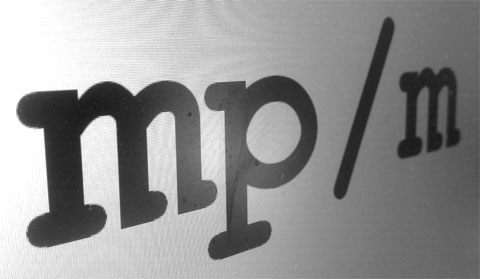
When It Began
I have used this signature for my emails dating back to when I was a kid. Then, the messages I was sending were over dial-in bulletin board systems (I have included a link to its definition if you don’t know what one is!). I would typically sign my messages with my initials, “MPM.” But why do I sign it now in lowercase, and what’s up with the slash between the P and the M? Here comes the geek part!
There was a single user operating system for microcomputers popular in the 1980’s called CP/M. It had a multi-user version called MP/M. When I learned of this I was intrigued – it was the same as my initials! I thought of signing my messages with “MP/M” but didn’t want any confusion with the operating system name, so I made the letters lower-case, thus “mp/m” was born as my signature.
Dial-in bulletin board systems were replaced by dial-in services like CompuServe and AOL. Those were replaced by Internet email. Yet through the decades, my signature remained the same.
That’s my story and I am sticking to it.
Go ahead – comment away on this, you won’t hurt my feelings!
This is from The Hot Iron, a journal on business and technology by Mike Maddaloni.
Did you enjoy this? Subscribe to The Hot Iron by RSS/XML feed or Read by Email.
Announcements • Blogging • Social Media • Strategize • Technology • (4) Comments • Permalink

